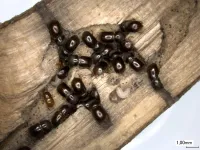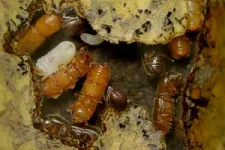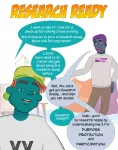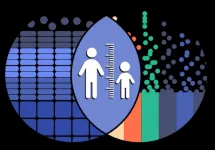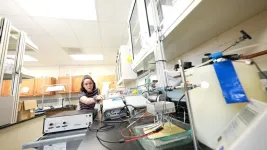(Press-News.org) Certain ambrosia beetles species engage in active agriculture. As social communities, they breed and care for food fungi in the wood of trees and ensure that so-called weed fungi spread less. Researchers led by Prof. Dr. Peter Biedermann, professor of Forest Entomology and Forest Protection at the University of Freiburg, now demonstrate for the first time that ambrosia beetles can distinguish between different species of fungi by their scents. "The results can contribute to a better understanding of why beetles selectively colonise trees with conspecifics and how exactly their fungiculture works," says Biedermann. "In addition, the scents of the fungi could be used to develop attractants to control non-native ambrosia beetles."
Beetles orientate themselves by fungal scents
A research team led by Biedermann and the environmental scientist Dr. Antonio Gugliuzzo from the University of Catania/Italy was able to show for the first time that the black stem borer (Xylosandrus germanus) perceives scents of its food fungi and that these act as so-called aggregation pheromones. This means that the beetle uses the scent of the food fungus to find trees that are already colonised by conspecifics. The beetle is an invasive species that is now widespread in Germany and is mainly found in fruit trees. The results have just been published in the journal Frontiers in Microbiology.
"Until now, we could not explain how these beetles attack trees in groups," says Biedermann - because no corresponding scent of the insects' own had been found so far. The experiment now showed that the beetles react to the scents of the specific food fungi that their conspecifics have already cultivated in the branches of a tree. "This enables the beetles to colonise weakened trees in greater numbers and to overcome the tree's defences more easily, thus causing the tree to die," says Biedermann. Further chemical analyses can now be done to determine a component of the fungus scent, which could then be used as an attractant for traps in fruit growing.
Even larvae can distinguish fungi
In another study, environmental scientist Denicia Kassie and biologist Janina Diehl were able to experimentally demonstrate for the first time that another ambrosia beetle species, the fruit-tree pinhole borer (Xyleborinus saxesenii), can recognise and distinguish between its food fungi and so-called weed or harmful fungi based on their scents. Diehl is a doctoral student with Biedermann at the University of Freiburg. "Depending on the condition of the fungi, the beetles in the experiments either specifically sought out the fungal cultures or avoided them," says Diehl. The ability to recognise a potential threat to food fungi or their own health gives the beetles the opportunity to react - and either avoid or specifically combat the harmful fungi. The results of the study have been published in the journal Symbiosis.
The scientists were able to demonstrate the ability to distinguish between different food and harmful fungi in both larvae and adult individuals of the fruit-tree pinhole borer - which each take on their own tasks in the social network in the social maintenance of the food fungus cultures. "These findings are another building block to better understand how the control of fungal breeding by ambrosia beetles works functionally," says Biedermann. "This could also result in ideas for our agriculture to control harmful organisms in a sustainable and environmentally friendly way."
Factual overview:
Original publications: Gugliuzzo, A., Kreuzwieser, J., Ranger, Ch. M., Tropea Garzia, G., Biondi, A., Biedermann, P. H. W.: Volatiles of fungal cultivars act as cues for host-selection in the fungus-farming ambrosia beetle Xylosandrus germanus. In: Front. Microbiol. 14:1151078 (2023).https://www.frontiersin.org/articles/10.3389/fmicb.2023.1151078/full
Diehl, J.M.C., Kassie, D., Biedermann, P.H.W.: Friend or foe: Ambrosia beetle response to volatiles of common threats in their fungus gardensSymbiosis (2023). https://link.springer.com/article/10.1007/s13199-023-00914-y
Peter Biedermann is Professor of Forest Entomology and Forest Conservation at the University of Freiburg. His research interests include bark beetles, symbioses between insects and microorganisms, especially fungi, and the social behaviour of insects. Janina Diehl is a doctoral student at the University of Freiburg, Denicia Kassie wrote her bachelor's thesis on the topic at the University of Freiburg. Antonio Gugliuzzo is a research assistant at the University of Catania/Italy.
The research was supported by a DAAD scholarship for Antonio Gigliuzzo, by an Emmy Noether Grant from the DFG for Peter Biedermann and by funding from the University of Freiburg for open access publications.
Contact:
University and science communication
University of Freiburg
Tel.: 0761/203-4302
E-mail: kommunikation@zv.uni-freiburg.de
END
Ambrosia beetles can recognise their food fungi by their scents
2023-04-14
ELSE PRESS RELEASES FROM THIS DATE:
Study snapshot: Following the letter of the law: 2020–2021 retention outcomes under Michigan’s Read by Grade Three Law
2023-04-14
Study: "Following the Letter of the Law: 2020–2021 Retention Outcomes Under Michigan’s Read by Grade Three Law"
Authors: Andrew Niel Utter (Michigan State University), John Westall (Michigan State University), Katharine O. Strunk (Michigan State University)
Embargoed until: 12:01 a.m. CT Friday, April 14
This study will be presented at the place-based component of the 2023 Annual Meeting of the American Educational Research Association.
Session: Minding the Gap in Accountability Policy Implementation
Date/Time: Friday, April 14, 2:50 p.m. – 4:20 p.m. CT
Main Findings:
Under Michigan’s “Read by Grade ...
The ACMG publishes statement on clinical, technical and environmental biases influencing equitable access to clinical genetics/genomics testing
2023-04-14
With the goal of fostering awareness and identifying strategies to reduce bias within the medical genetics field and to improve health equity, members of the ACMG’s Social, Ethical and Legal Issues (SELI) and Diversity, Equity and Inclusion (DEI) Committees collaborated to address factors in which bias can occur in clinical genetic testing in a just-published statement, “Clinical, technical, and environmental biases influencing equitable access to clinical genetics/genomics testing: A points to consider statement of the American College of Medical Genetics and Genomics (ACMG)”.
This is the first joint statement of the ACMG’s ...
Improving community outreach and engagement
2023-04-14
As researchers continue to make advances in new cancer prevention and treatment methods, it will not have much impact if the community is unaware and not engaged. For this reason, community outreach and engagement (COE) efforts are an important pillar of the University of Cincinnati Cancer Center’s mission.
Cancer Center researchers will present research abstracts on several COE initiatives at the American Association for Cancer Research Annual Meeting 2023, held in Orlando, Florida, April 14-19.
Encouraging ...
Healing the unhealable: New approach helps bones mend themselves
2023-04-14
Young babies and newborn mice can naturally heal damage to the bones that form the top of the skull, but this ability is lost in adults. In a new study published in Proceedings of the National Academy of Sciences, University of Pittsburgh researchers developed a novel approach that promoted bone regeneration in mice without implantation of bone tissue or biomaterials.
The technique uses a device similar to an orthodontic wire used to realign teeth to carefully stretch the skull along its sutures, activating ...
Scientists narrow down pool of potential height genes
2023-04-14
When it comes to height, our fate is sealed along with our growth plates—cartilage near the ends of bones that hardens as a child develops. Research publishing April 14 in the journal Cell Genomics shows that cells in these plates determine the length and shape of our bones and can hint at our stature. The study identified potential "height genes" and found that genetic changes affecting cartilage cell maturation may strongly influence adult height.
"The study is really understanding ...
Finding the dream team to beat the heat
2023-04-14
Associate Professor Jonathan Boreyko leads a team at Virginia Tech that has built a strong portfolio of work with ice and water, exploring the possibilities for de-icing planes, building novel water harvesting devices, and creating snow globes out of bubbles. This familiarity with water has given the team a strong sense of its behavior in different states, leading to a new project that shows how ice quenches heat in comparison to water. The findings were published in Chem on April 14.
Mojtaba Edalatpour and master’s student Camryn ...
Analysis of health and prescription data suggests chronic health conditions in U.S. incarcerated people may be severely undertreated
2023-04-14
Chronic conditions such as type 2 diabetes, asthma, HIV infection, and mental illness may be greatly undertreated in the U.S. jail and prison population, suggests a new study from researchers at the Johns Hopkins Bloomberg School of Public Health.
For their analysis, the researchers used national health survey data covering 2018 to 2020 to estimate rates of chronic conditions among recently incarcerated people, and a commercial prescription database to estimate the distribution of medication treatments to the jail and prison population. Their analysis suggests ...
In-person vs virtual education and community COVID-19 case incidence following school re-openings
2023-04-14
About The Study: In a study of matched pairs of counties that reopened with in-person versus virtual instruction at the secondary school level in the 2020 to 2021 academic year, counties with in-person school instructional models early in the COVID-19 pandemic experienced increases in county-level COVID-19 incidence at six and eight weeks after in-person reopening, compared with counties with virtual instructional models.
Authors: Meredith Matone, Dr.P.H., of Children’s Hospital of Philadelphia, is the corresponding author.
To access the embargoed study: Visit our For The ...
Black representation in the primary care physician workforce and its association with population life expectancy
2023-04-14
About The Study: The findings of this study of survival outcomes for 1,618 U.S. counties suggest that greater representation of Black primary care physicians (PCPs) in the PCP workforce is associated with improved survival-related outcomes for Black individuals, although there was a dearth of U.S. counties with at least one Black PCP during each study time point. Investments to build a more representative PCP workforce nationally may be important for improving population health.
Authors: John E. Snyder, M.D., M.S., M.P.H., and Rachel D. Upton, Ph.D., of the U.S. Department of Health and Human Services in Rockville, Maryland, are the corresponding ...
Racial, ethnic differences in barriers faced by medical college admission test examinees
2023-04-14
About The Study: In this study of 81,755 Medical College Admission Test examinees, American Indian or Alaska Native, Black, and Hispanic students reported lower parental educational levels, greater educational and financial barriers, and greater discouragement from pre-health advisers than white students. These barriers may deter groups underrepresented in medicine from applying to and matriculating at medical school.
Authors: Jessica Faiz, M.D., M.S.H.P.M., of the Veterans Affairs Greater Los Angeles Healthcare System and UCLA in Los Angeles, is the corresponding ...
